
1.1 TB incidence
Box 1.1.1 provides a summary of the methods used to produce estimates of TB incidence for the period 2010–2023. For 47 countries that experienced considerable disruptions to TB services during the COVID-19 pandemic (in terms of reductions in TB case notifications that were a clear departure from historic trends), these methods include the use of country or region-specific dynamic models for the period 2020–2023. Although the numbers of people being newly diagnosed and notified as a TB case recovered to pre-pandemic levels in almost all of these countries by 2022 or 2023 (Section 2.1), models have continued to be used because the effects of even temporary disruptions on incidence can persist for several years, as a result of the slow natural history of TB (1, 2, 3).
As new data become available to inform estimates of TB incidence from 2024 onwards, the use of these models can be phased out.
An estimated global total of 10.8 million people (95% uncertainty interval [UI]: 10.1–11.7 million) fell ill with TB in 2023, equivalent to 134 incident cases (95% UI: 125–145) per 100 000 population (Table 1.1.1). Among all incident TB cases, 6.1% were among people living with HIV. Most TB cases in 2023 were in the WHO regions of South-East Asia (45%), Africa (24%) and the Western Pacific (17%), with smaller shares in the Eastern Mediterranean (8.6%), the Americas (3.2%) and Europe (2.1%).
| Region or country group | Population | Best estimate | Low | High | Best estimate | Low | High | Best estimate | Low | High | Best estimate | Low | High |
|---|---|---|---|---|---|---|---|---|---|---|---|---|---|
| African Region | 1 240 000 | 2 550 | 2 250 | 2 870 | 461 | 393 | 535 | 206 | 182 | 232 | 37 | 32 | 43 |
| Region of the Americas | 1 040 000 | 342 | 309 | 376 | 42 | 37 | 48 | 33 | 30 | 36 | 4.1 | 3.6 | 4.6 |
| South-East Asia Region | 2 100 000 | 4 910 | 4 420 | 5 430 | 99 | 80 | 121 | 234 | 211 | 259 | 4.7 | 3.8 | 5.8 |
| European Region | 939 000 | 225 | 190 | 264 | 29 | 22 | 38 | 24 | 20 | 28 | 3.1 | 2.3 | 4.0 |
| Eastern Mediterranean Region | 810 000 | 936 | 723 | 1 170 | 4.7 | 3.6 | 6.0 | 116 | 89 | 145 | 0.58 | 0.44 | 0.74 |
| Western Pacific Region | 1 940 000 | 1 880 | 1 420 | 2 400 | 25 | 21 | 30 | 97 | 73 | 124 | 1.3 | 1.1 | 1.5 |
| High TB burden countries | 4 970 000 | 9 410 | 8 620 | 10 200 | 526 | 455 | 602 | 189 | 173 | 206 | 11 | 9.2 | 12 |
| Global | 8 060 000 | 10 800 | 10 100 | 11 700 | 662 | 589 | 739 | 134 | 125 | 145 | 8.2 | 7.3 | 9.2 |
The estimated 10.8 million people (95% UI: 10.1–11.7 million) who fell ill with TB worldwide in 2023 is an increase from 10.7 million in 2022 (95% UI: 10.0–11.5 million), 10.4 million (95% UI: 9.7–11.1 million) in 2021 and 10.1 million (95% UI: 9.5–10.7 million) in 2020, continuing the reversal of the downward trend that had been sustained for many years up to 2020 (Fig. 1.1.1, panel a). The TB incidence rate (new cases per 100 000 population per year) is estimated to have increased only slightly (by 0.2%) between 2022 and 2023 (Fig. 1.1.1, panel b), a much smaller amount than the 2.2% between 2021 and 2022.
The three consecutive years of increasing global TB incidence from 2021–2023 mean that in 2023, the TB incidence rate returned to the level of 2018 (Fig. 1.1.1, panel b). Globally, the net reduction in the TB incidence rate from 2015 to 2023 was 8.3%, far from the WHO End TB Strategy milestone of a 50% reduction by 2025 (4, 5).
(a) Number
(b) Rate per 100 000 population
The estimated increases in TB incidence in 2021–2023 are the consequence of disruptions to TB diagnosis and treatment during the COVID-19 pandemic, when the reported number of people newly diagnosed with TB fell from 7.1 million in 2019 to 5.8 million in 2020 and 6.4 million in 2021 (Section 2.1). These reductions are assumed to have resulted in an increase in the number of people with undiagnosed and untreated TB (with the dynamic models used for 47 countries also allowing for reductions in transmission during periods of lockdowns as well as some level of underreporting).
The most immediate impact of an increase in the number of people with undiagnosed and untreated TB was an increase in TB mortality (Section 1.2), but it also resulted in increased transmission of TB infection and then, with a lag time (given that the time from infection to progression to TB disease ranges among individuals from months to years), a subsequent increase in the number of people developing TB disease. Similarly, the most immediate impact of the big global recovery in the reported number of people newly diagnosed with TB in 2022 and 2023 (Section 2.1) has been a reduction in TB mortality. Reversing the global increase in TB incidence will take longer. Based on current trends, the global increase in the number of incident cases is slowing and may stabilize or reverse in the next one or two years.
In 2023, eight countries accounted for more than two thirds of global TB cases: India (26%), Indonesia (10%), China (6.8%), the Philippines (6.8%), Pakistan (6.3%), Nigeria (4.6%), Bangladesh (3.5%) and the Democratic Republic of the Congo (3.1%) (Fig. 1.1.2).
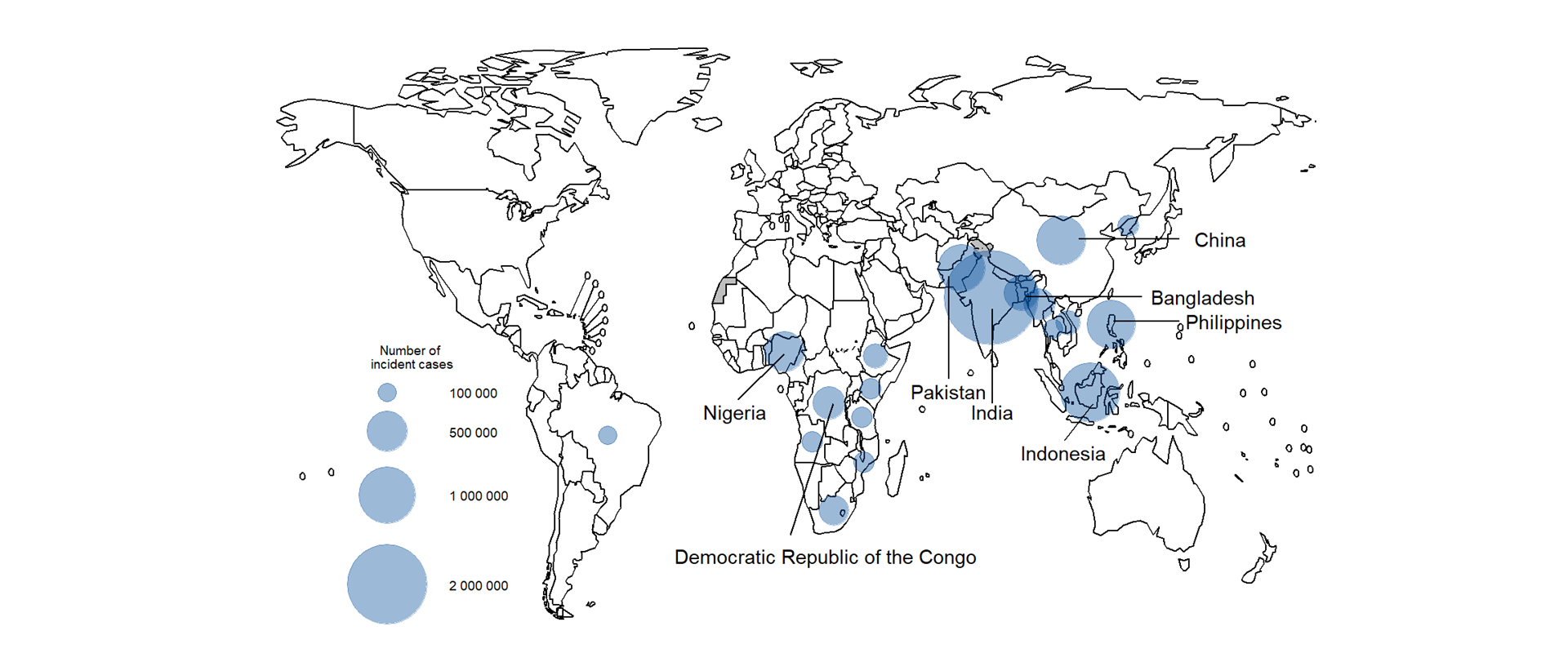
The severity of national TB epidemics, in terms of the number of incident TB cases per 100 000 population in 2023, varies widely among countries: from less than ten to more than 500 cases per 100 000 population (Fig. 1.1.3).
Countries with the highest annual rates were mostly in the African Region. There were 60 countries with a low incidence of TB (<10 cases per 100 000 population per year), mostly in the WHO Region of the Americas and the European Region, plus a few countries in the WHO Eastern Mediterranean and Western Pacific regions.
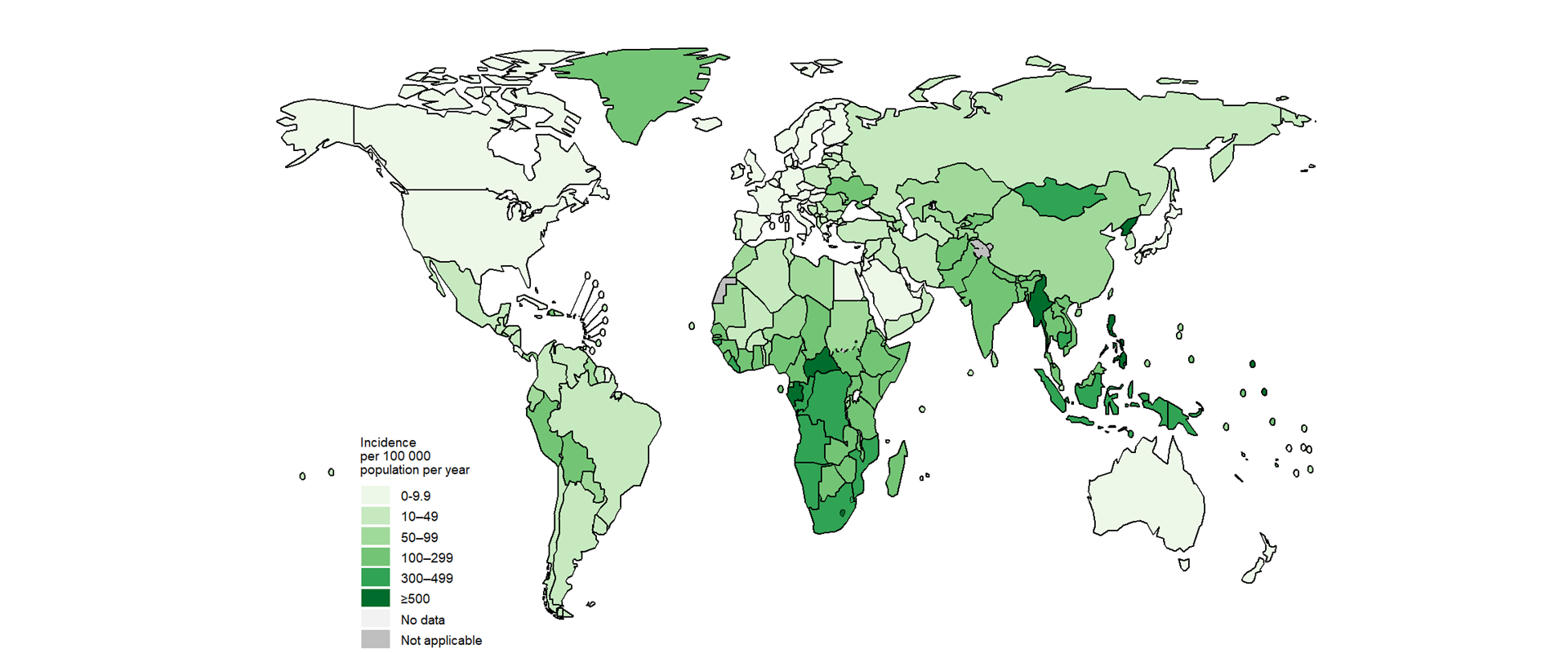
In 2023, the proportion of people with a new episode of TB (either new or relapse cases) who were living with HIV was highest in countries in the WHO African Region, exceeding 50% in parts of southern Africa (Fig. 1.1.4).
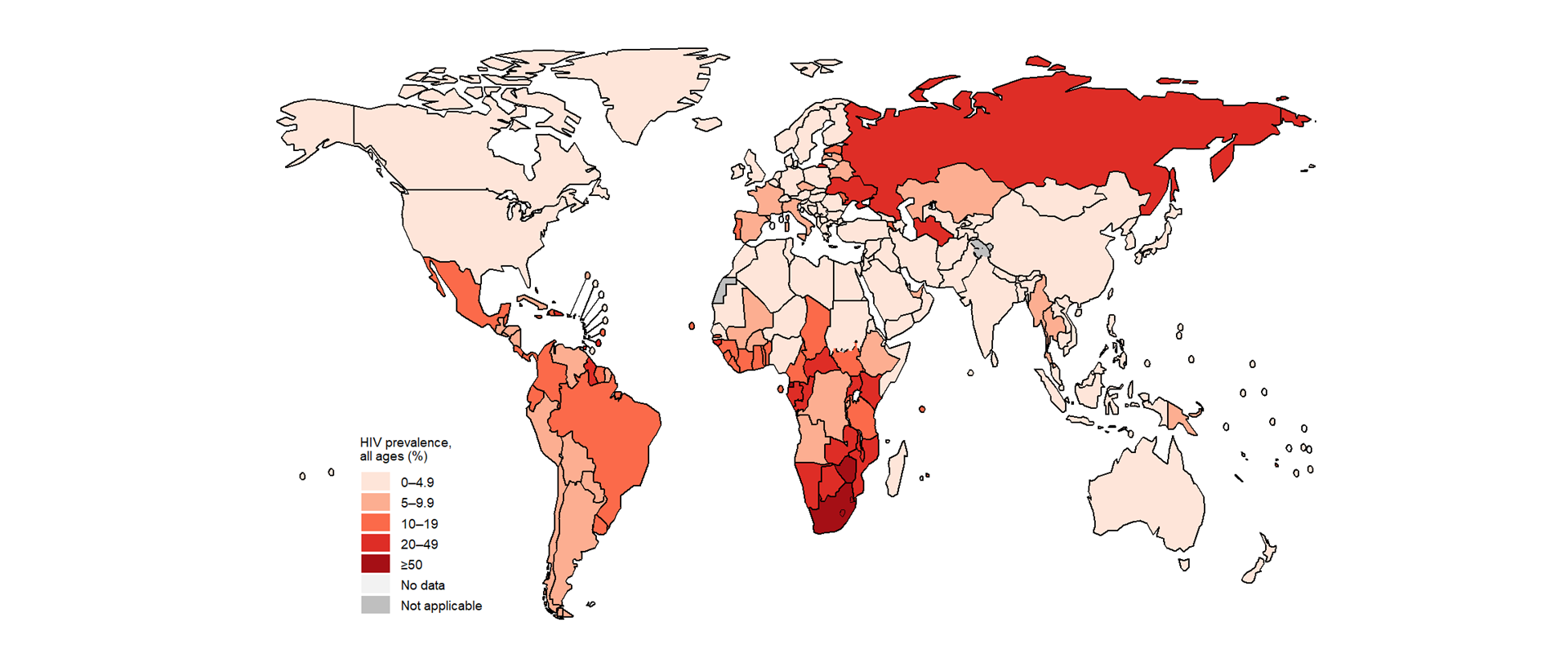
TB can affect anyone, regardless of age or sex (Fig. 1.1.5). The highest burden is in adult men (aged ≥15 years), with an estimated 6.0 million cases (95% UI: 5.5–6.4 million) in 2023, equivalent to 55% of the estimated total; by comparison, there were an estimated 3.6 million cases (95% UI: 3.3–3.9 million) among adult women (aged ≥15 years), equivalent to 33% of the estimated total, and 1.25 million (95% UI: 1.16–1.35 million) cases among children (aged 0–14 years), equivalent to 12% of the estimated total. Case notifications of people newly diagnosed with TB in 2023 were 75% of the estimated TB incidence overall but this varied by age and sex: 76% for adult men, 80% for adult women and 55% for children aged 0–14 years. Among children aged <5 years, the figure was only 48%.
Regional estimates of the distribution of incident TB cases, disaggregated by age and sex and compared with case notifications, are shown in Fig. 1.1.6. The largest numbers are typically in the age groups of 25–34, 35–44 or 45–54 years. The WHO Western Pacific Region is an exception, with the largest number of cases in the age group ≥65 years; this is mostly influenced by numbers for China, and can be explained by the country’s aging population and declining burden of TB disease (with higher rates of infection and a higher risk of new cases arising from reactivation of previous infections among older people).
Regional trends in TB incidence rates vary, and progress in relation to the 2025 milestone of the End TB Strategy is mixed (Fig. 1.1.7).
In 2023, the TB incidence rate increased for the third consecutive year in the Region of the Americas and the Western Pacific Region, reflecting the estimated impact of shortfalls in TB case detection in 2020 and incomplete recovery in 2021 (in both regions) as well as 2022 (in the Western Pacific). An upward trend in 2020–2022 was reversed in 2023 in two regions: the Eastern Mediterranean Region and the South-East Asian Region. In the European Region, the TB incidence rate started to decrease in 2022. In the African Region, the decline that has been sustained for many years was maintained in 2023, consistent with evidence that disruptions related to the COVID-19 pandemic had little impact on the number of people diagnosed and officially notified with TB (Section 2.1).
The biggest estimated reduction in the TB incidence rate compared with the baseline year of 2015 has been in the European Region, with a net reduction of 27% by 2023. A similar reduction has been achieved in the African Region, with a 24% decline by 2023. The net decline by 2023 compared with 2015 was relatively small in three of the remaining WHO regions: the Eastern Mediterranean (3.4%), South-East Asia (6.7%) and the Western Pacific (3.5%). The most concerning trend is in the Region of the Americas, where there was a net increase of 20% between 2015 and 2023.
Trends in TB incidence rates by income group are shown in (Fig. 1.1.8).
Progress in reducing the TB incidence rate at country level is highly variable (Fig. 1.1.9). Many countries, especially in the European and African regions, have achieved estimated reductions of more than 20% between 2015 and 2023, thus surpassing the first (2020) milestone of the End TB Strategy. More than 10 countries are estimated to have achieved reductions of at least 50% between 2015 and 2023, including one high TB burden country (South Africa). At the other extreme, there are countries where the TB incidence rate in 2023 was more than 5% higher than in 2015. These countries are most noticeably in the Region of the Americas but also include four high TB burden countries in Asia: Indonesia, Mongolia, Myanmar and the Philippines.
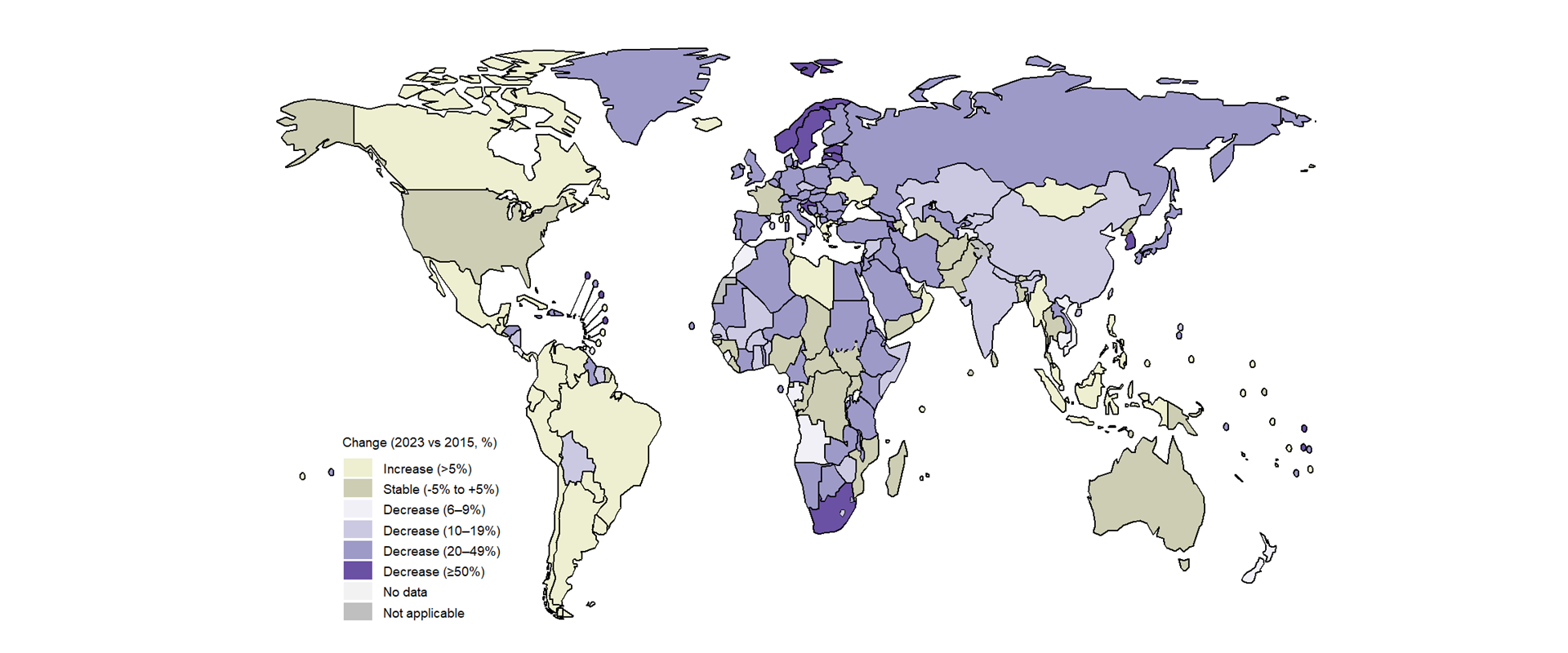
Trends in the TB incidence rate in the 30 high TB burden countries are also highly variable (Fig. 1.1.10). In 2023, the best estimate of the TB incidence rate suggested that the 2025 milestone of the End TB Strategy had been reached in South Africa and was close to being reached in Kenya, the United Republic of Tanzania and Zambia.
In 2021, 2022 and 2023, the estimated TB incidence rate increased in two of the three global TB watchlist countries, while the Russian Federation is close to reaching the 2025 milestone of the End TB Strategy (Fig. 1.1.11).
Box 1.1.1
Methods used by WHO to estimate TB incidence
The main methods used by WHO to estimate TB incidence at country level in the period 2010–2023 are shown in Fig. 1.1.12. These methods adhere to global guidelines for accurate and transparent reporting of health estimates (6) and are described in detail in a technical appendix.
Methods used by WHO to estimate TB incidence for 2000–2019 included:
results from national TB prevalence surveys combined with estimates of the duration of disease, used for 28 countries with 39% of the global number of incident TB cases in 2019;
results from a national TB prevalence survey combined with a country-specific dynamic model that was calibrated to survey data as well as other data (e.g. notifications, drug sales) and WHO TB mortality estimates. This was used for India, which had 27% of the global number of incident TB cases in 2019;
notifications adjusted by a standard factor to account for underreporting, overdiagnosis and underdiagnosis, used for 137 countries (including most high-income countries and selected middle-income countries and areas) with about 6.0% of the global number of incident TB cases in 2019;
results from national inventory studies that measured the level of underreporting of detected TB cases, used for 10 countries with about 17% of the global number of incident TB cases in 2019; and
case notification data combined with expert opinion about case-detection gaps, used for 39 countries with 11% of the global number of incident TB cases in 2019.
For 47 countries with the biggest absolute reductions in TB notifications during the COVID-19 pandemic that were a clear departure from historic trends, estimates of TB incidence in 2020–2023 were based on country or region-specific dynamic models (n=24 and n=23, respectively). These methods are described in detail elsewhere (1, 2, 3). For all other countries, the same methods as those used for the period 2010–2019 continued to be applied.
The orange dots on the map show the 24 countries for which a country-specific dynamic model has been used and the brown dots show the 23 countries for which a region-specific dynamic model has been used. These two groups of countries accounted for 62% and 0.7% of the estimated total global number of incident cases in 2023, respectively.
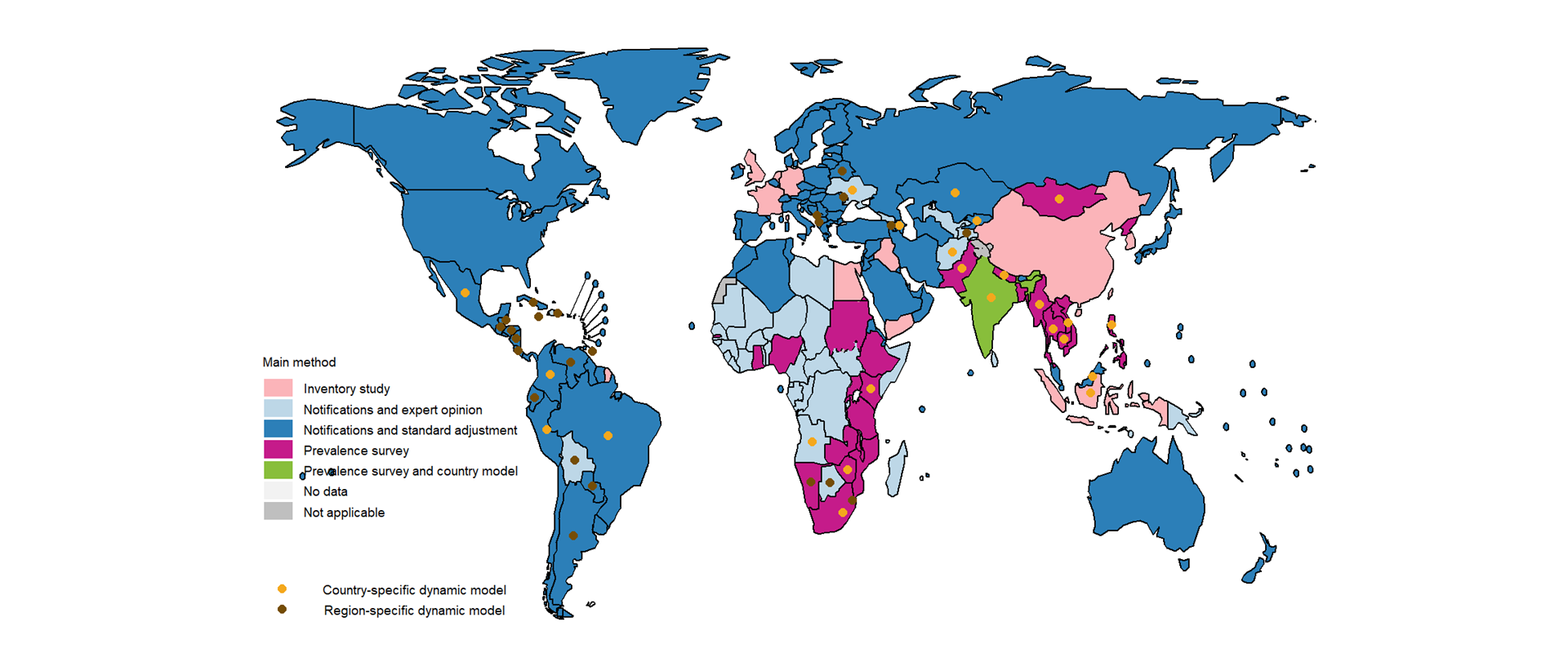
Country-specific details are available in the Global tuberculosis report app and country profiles.
Note: All of the percentage reductions or increases referred to in the text of this webpage were calculated based on unrounded numbers, as opposed to the rounded numbers that appear in the interactive graphics.
References
Global tuberculosis report 2021. Geneva: World Health Organization; 2021 ( https://iris.who.int/handle/10665/346387).
Global tuberculosis report 2022. Geneva: World Health Organization; 2022 ( https://iris.who.int/handle/10665/363752).
Global tuberculosis report 2023. Geneva: World Health Organization; 2023 ( https://iris.who.int/handle/10665/373828).
Floyd K, Glaziou P, Houben R, Sumner T, White RG, Raviglione M. Global tuberculosis targets and milestones set for 2016-2035: definition and rationale. Int J Tuberc Lung Dis. 2018;22(7):723-30 (https://doi.org/10.5588/ijtld.17.0835).
World Health Organization. Resolution WHA67.1. Global strategy and targets for tuberculosis prevention, care and control after 2015. Geneva: World Health Organization; 2014 ( http://apps.who.int/gb/ebwha/pdf_files/WHA67/A67_R1-en.pdf).
Guidelines for Accurate and Transparent Health Estimates Reporting (GATHER) [website] ( http://gather-statement.org/).
